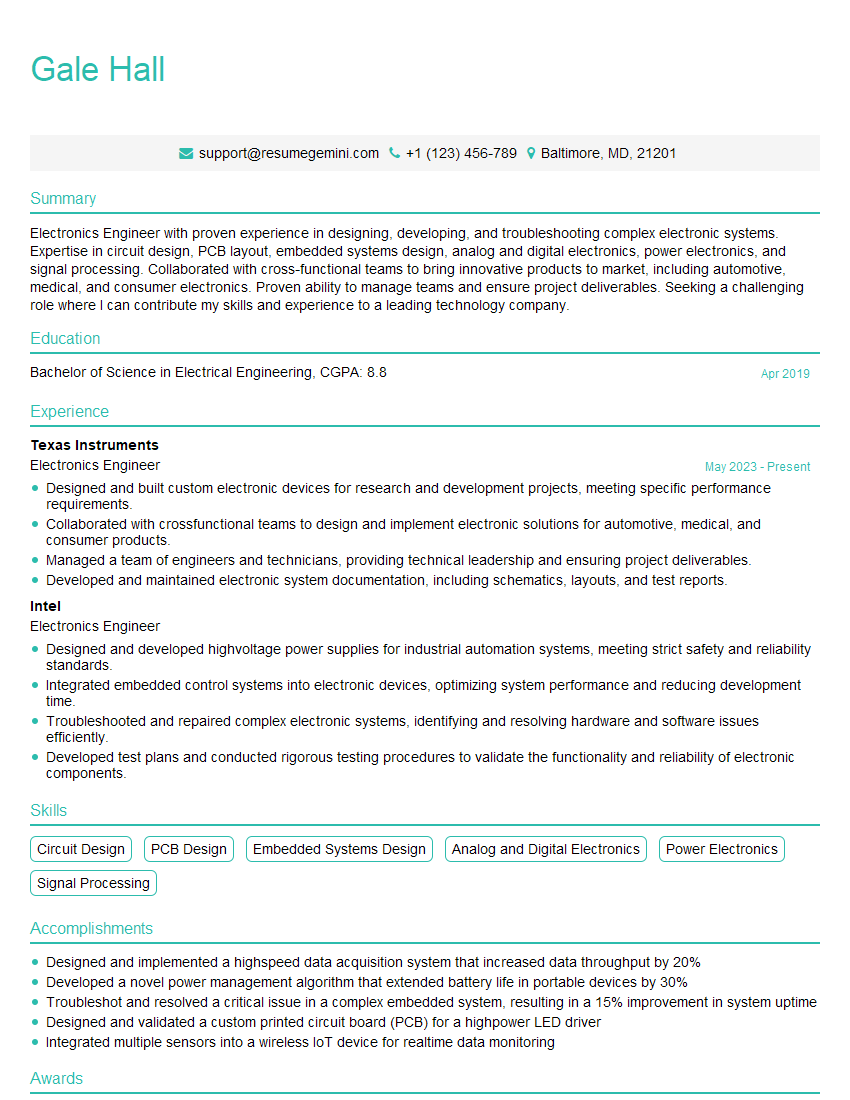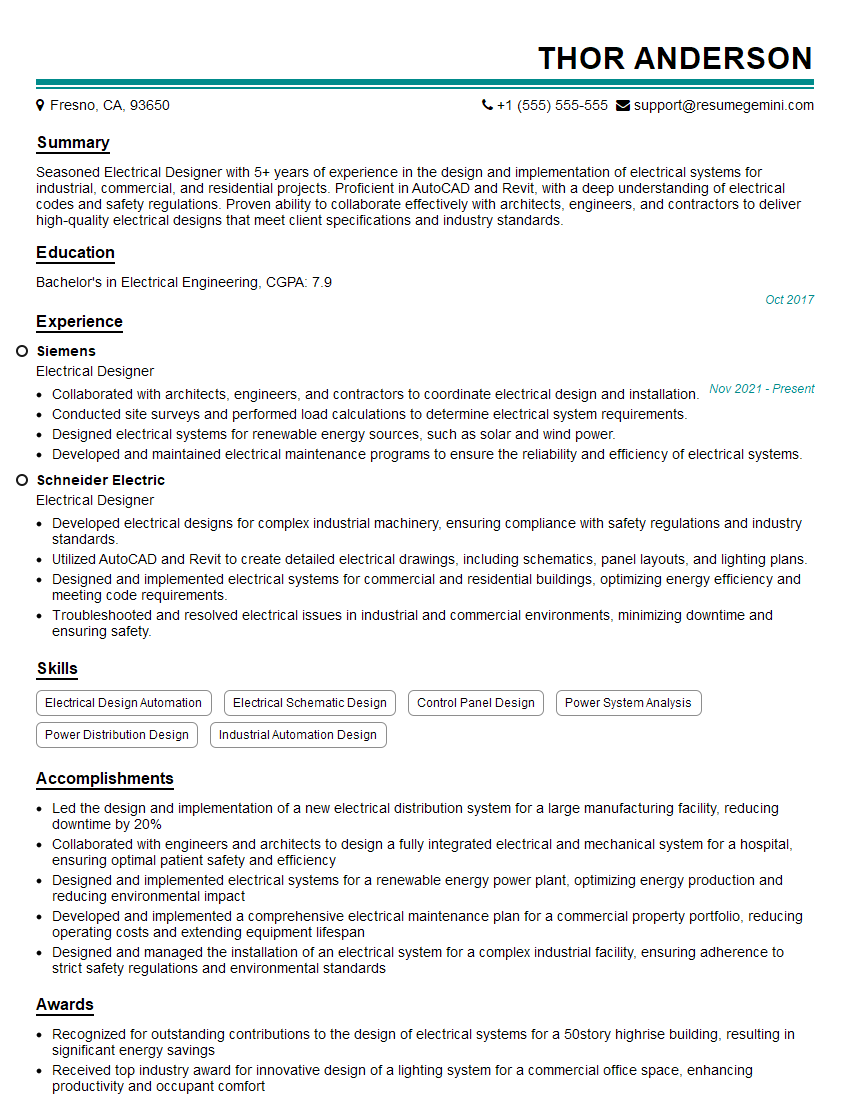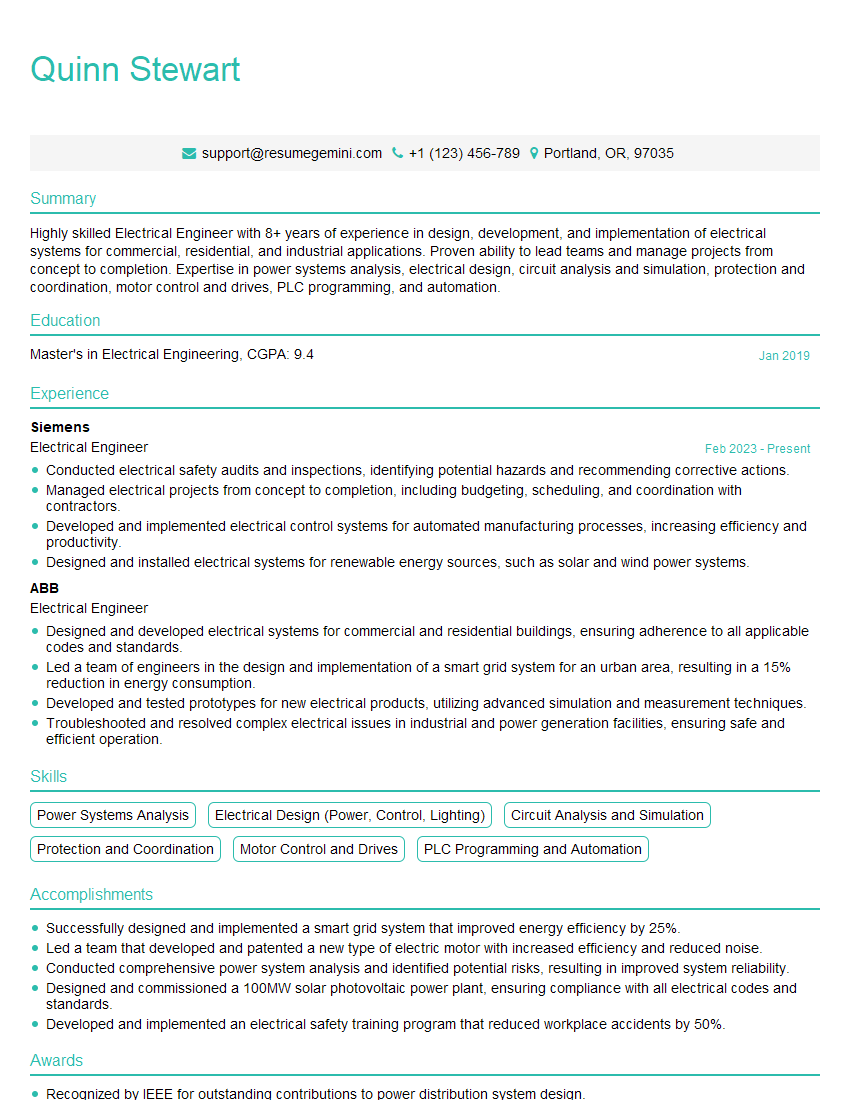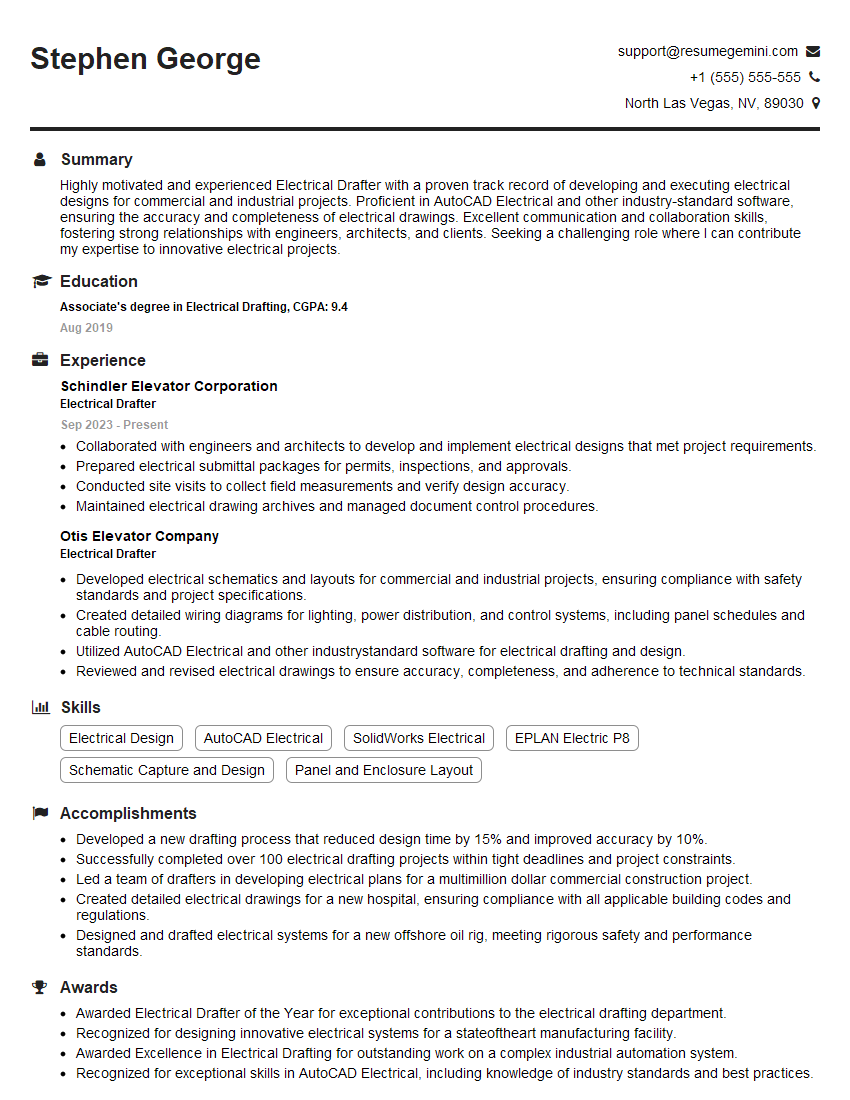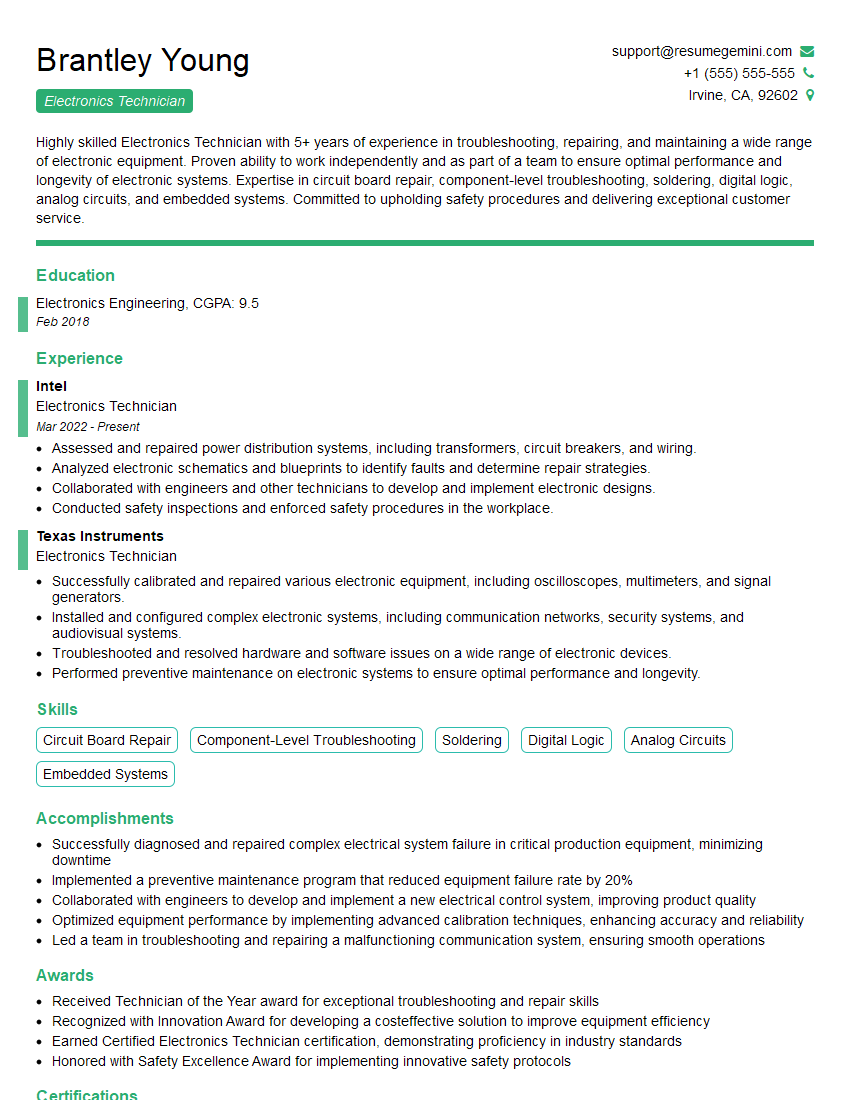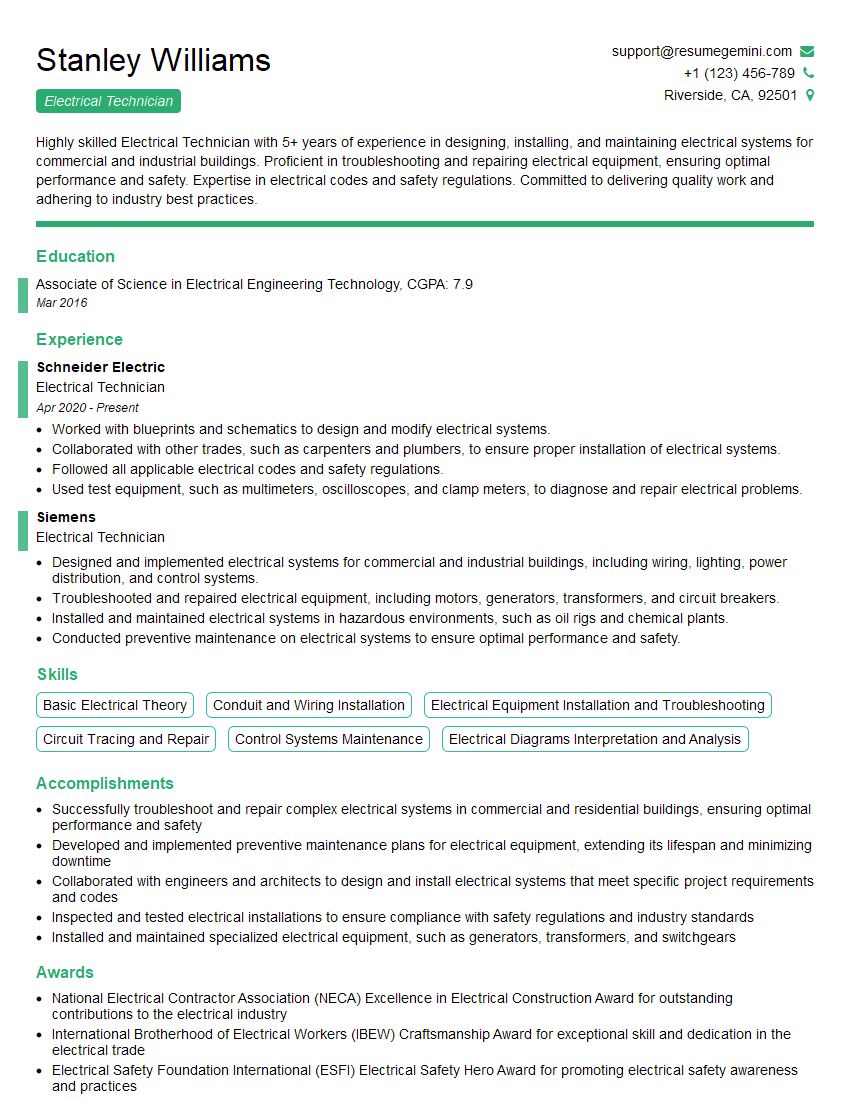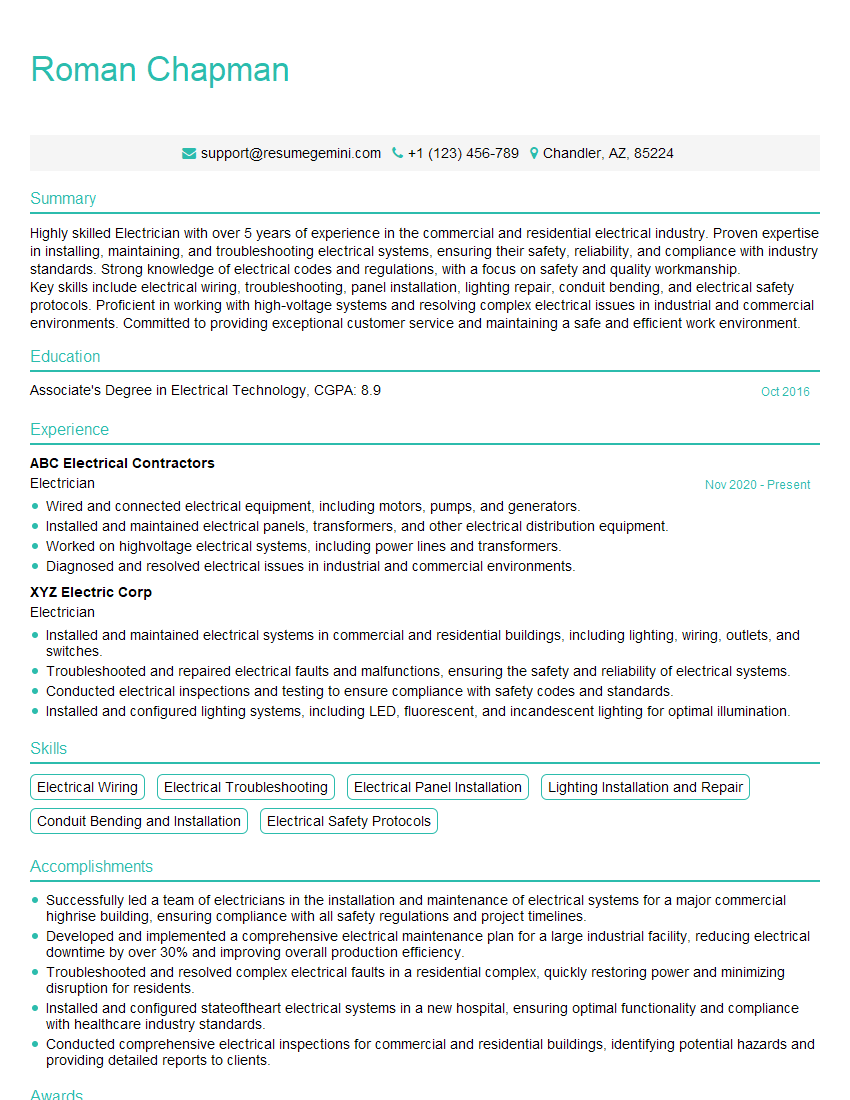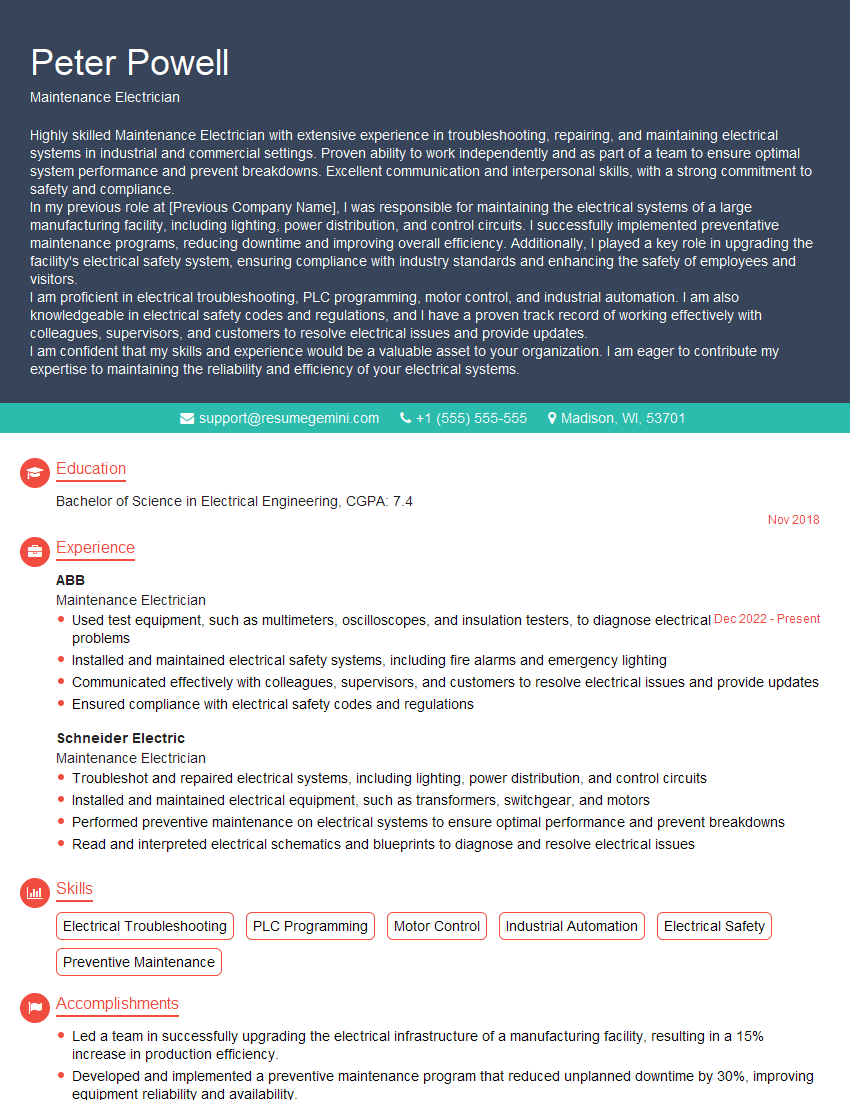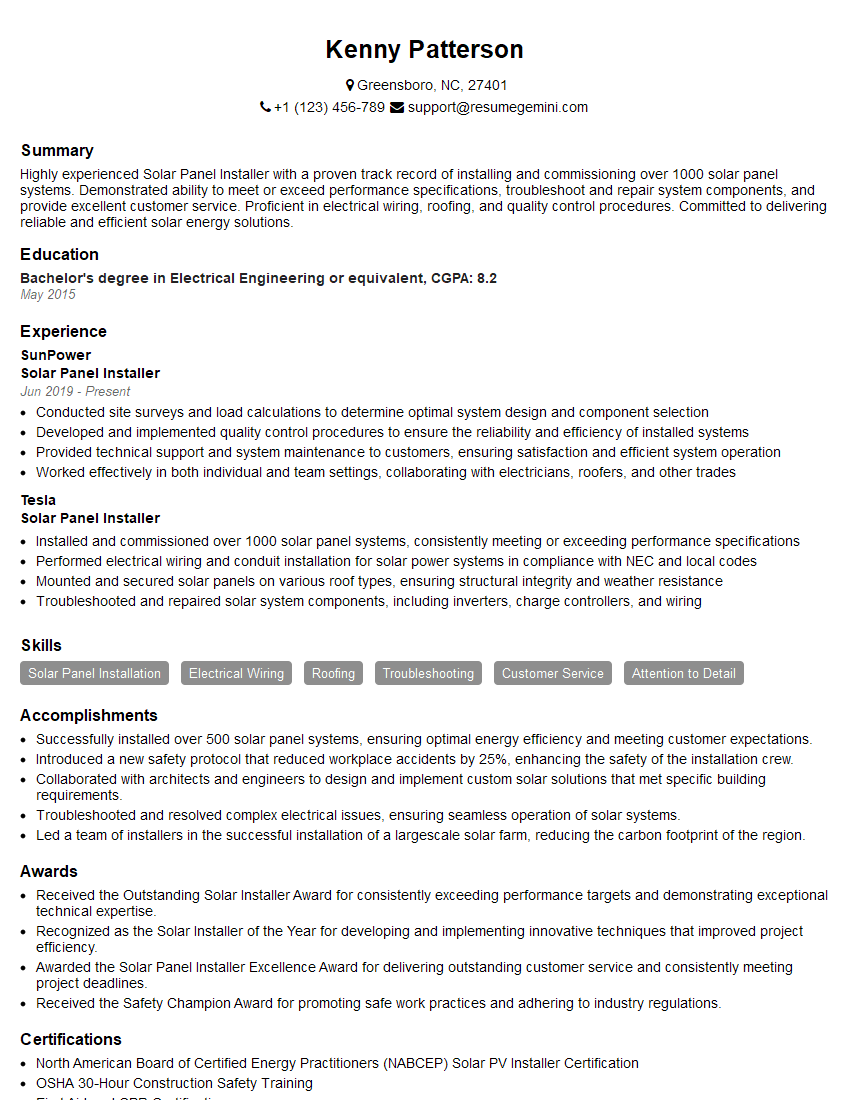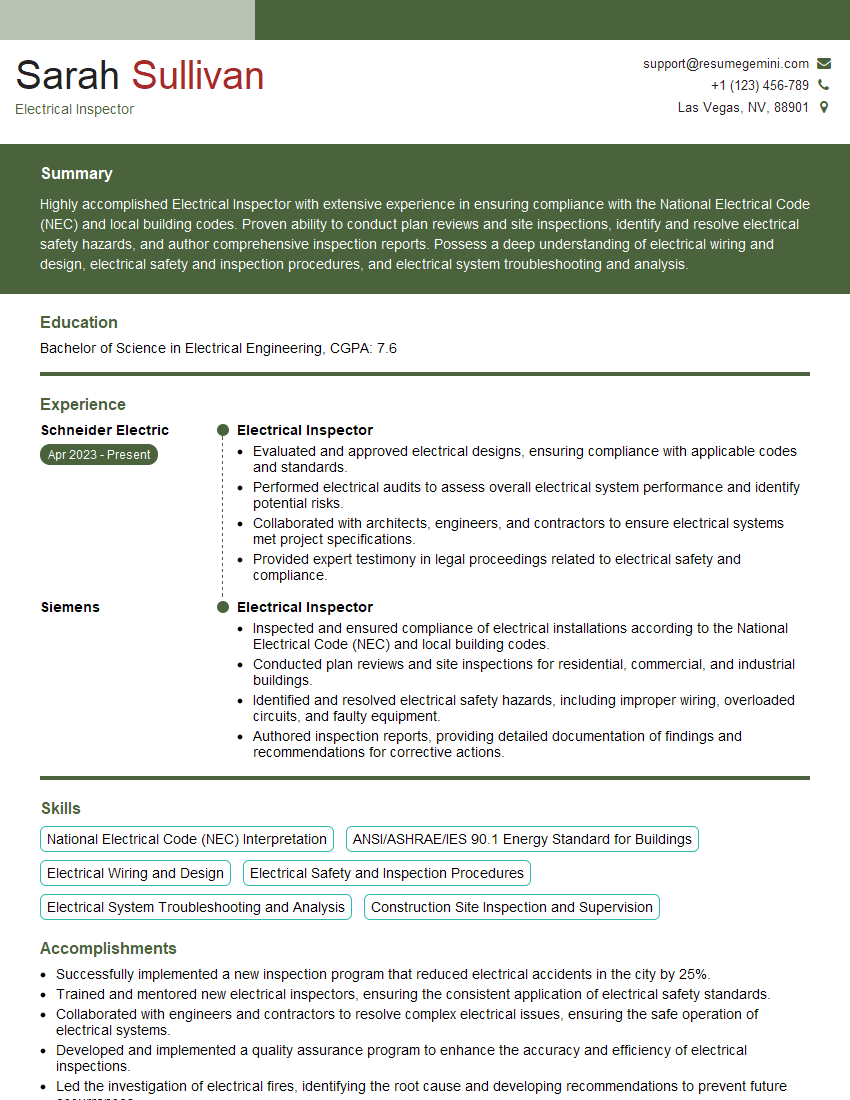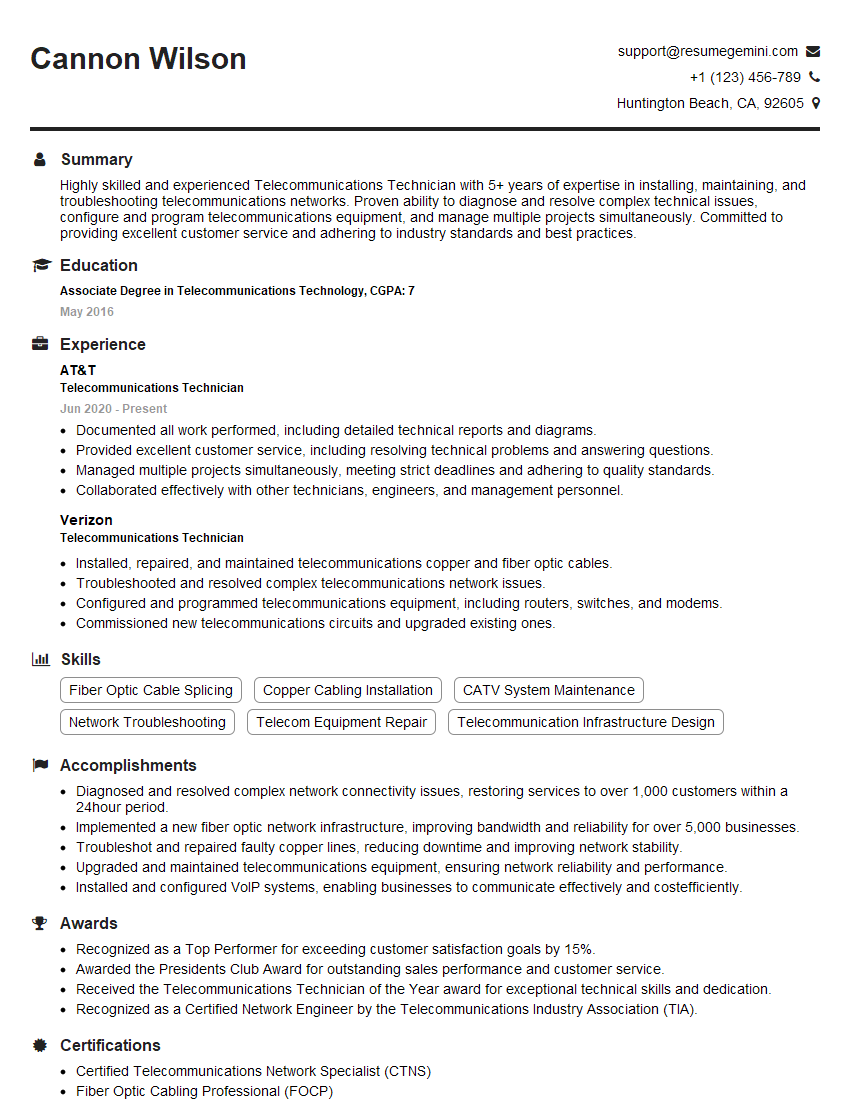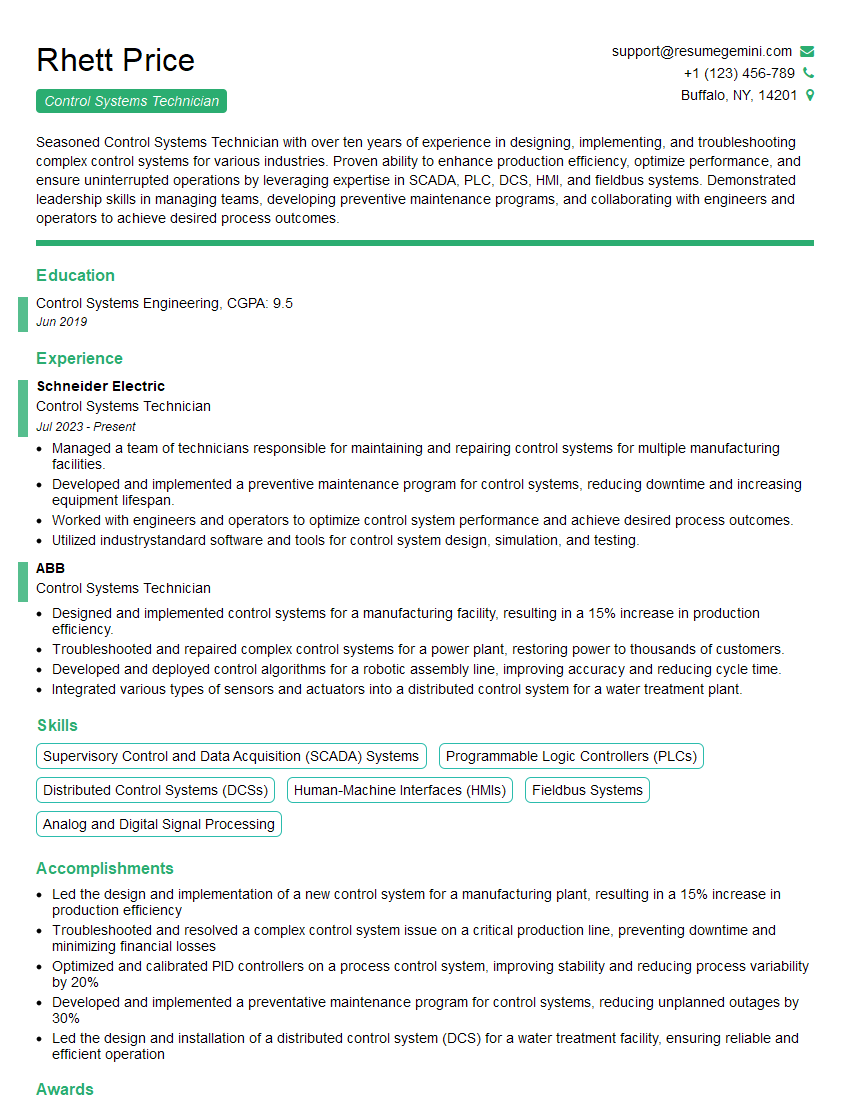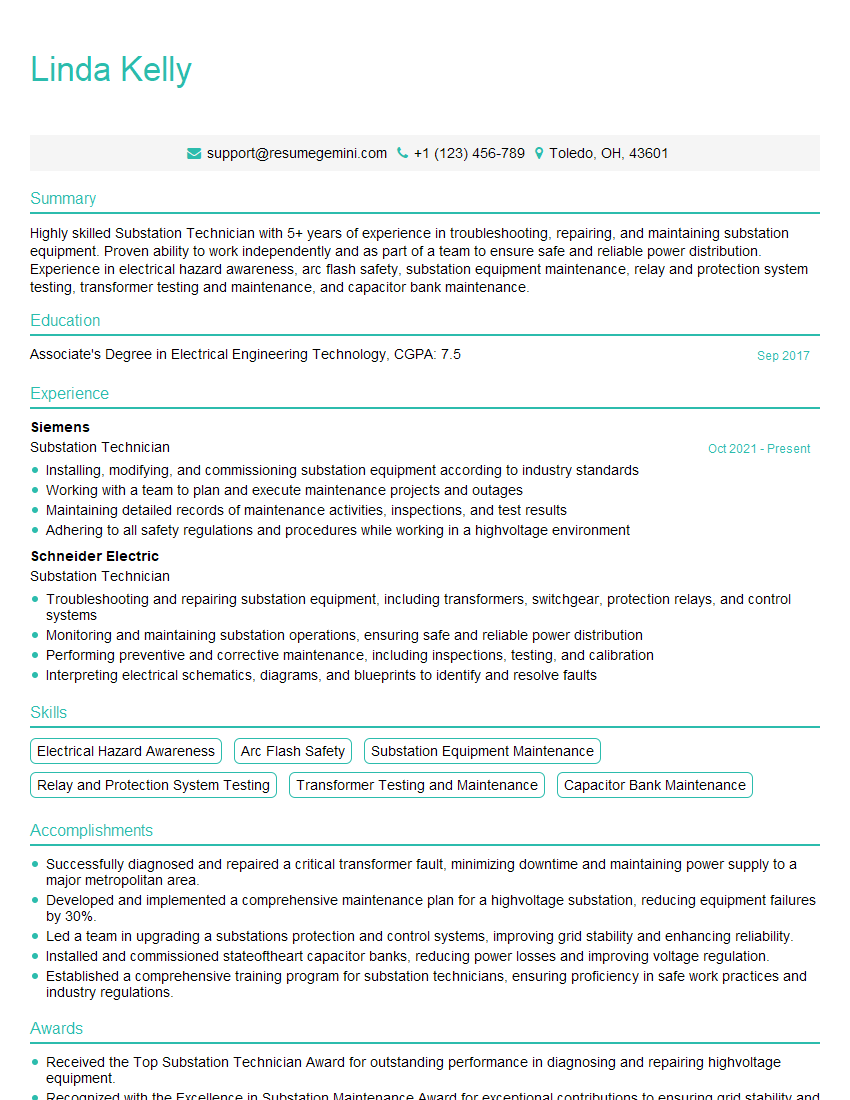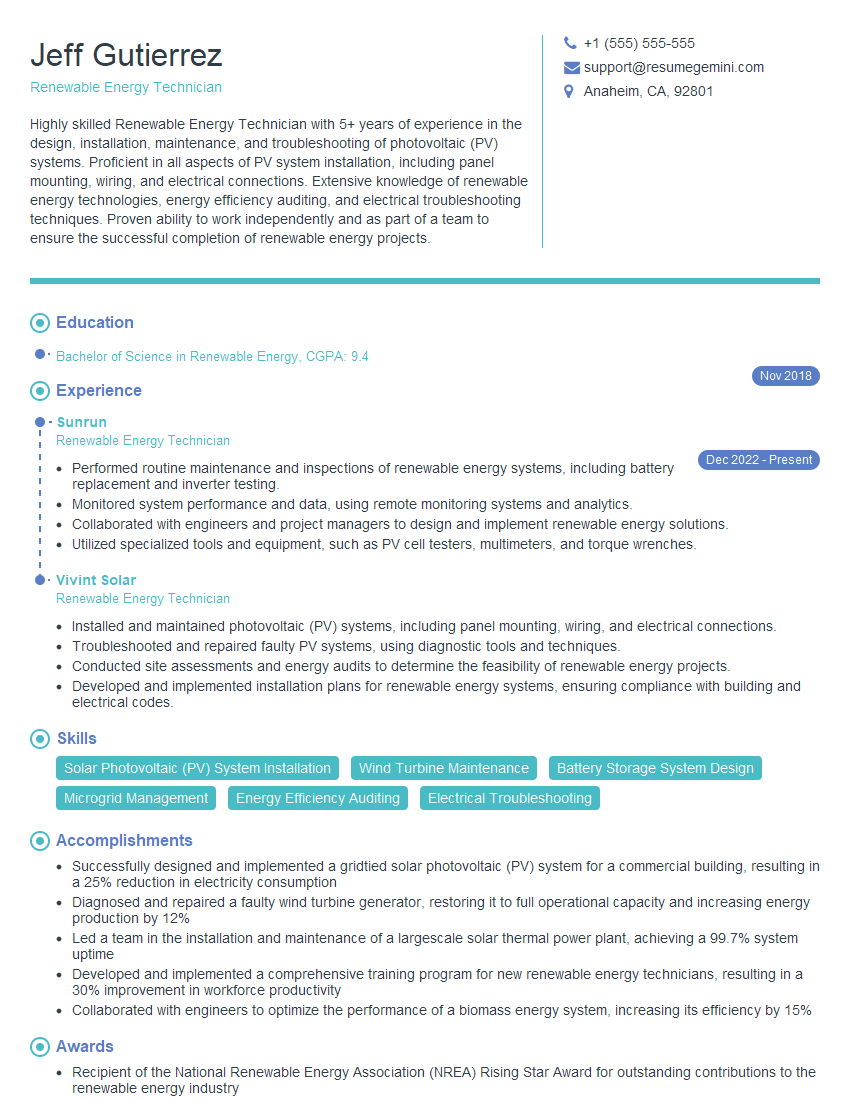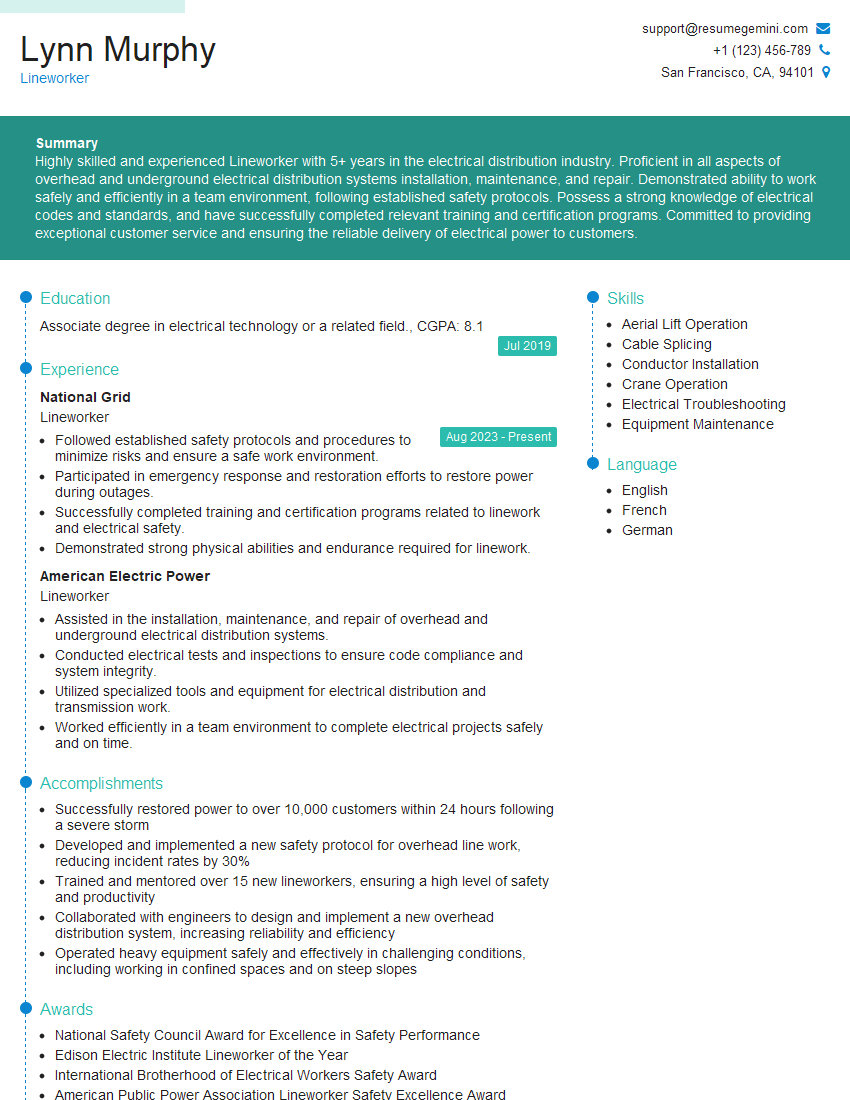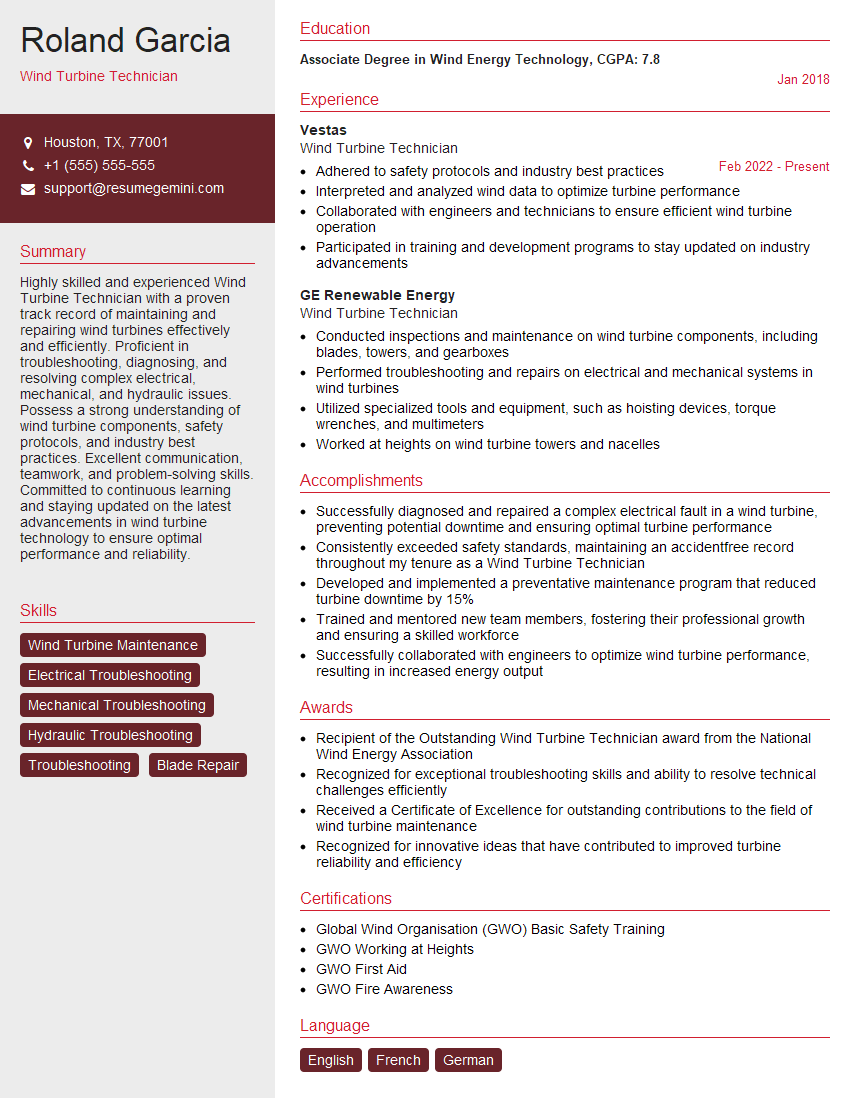Are you ready to stand out in your next interview? Understanding and preparing for Basic Electricity interview questions is a game-changer. In this blog, we’ve compiled key questions and expert advice to help you showcase your skills with confidence and precision. Let’s get started on your journey to acing the interview.
Questions Asked in Basic Electricity Interview
Q 1. Explain Ohm’s Law and its applications.
Ohm’s Law describes the relationship between voltage, current, and resistance in an electrical circuit. It states that the current flowing through a conductor is directly proportional to the voltage across it and inversely proportional to its resistance. This is mathematically represented as: V = IR, where V is voltage (measured in volts), I is current (measured in amperes), and R is resistance (measured in ohms).
Applications: Ohm’s Law is fundamental to electronics and electrical engineering. It’s used to:
- Calculate the current: If you know the voltage and resistance of a circuit, you can calculate the current flowing through it. For example, if a 12V battery is connected to a 6Ω resistor, the current is
I = V/R = 12V / 6Ω = 2A. - Determine the resistance: If you know the voltage and current, you can find the resistance of a component. This is crucial for troubleshooting circuits.
- Calculate the voltage: Knowing the current and resistance, you can determine the voltage drop across a component.
- Design circuits: Ohm’s Law allows engineers to design circuits with specific current and voltage requirements by selecting appropriate resistors.
Think of it like this: Voltage is the pressure pushing the electrons (current) through a pipe (resistor). The more pressure (voltage), the more water (current) flows. A narrower pipe (higher resistance) restricts the flow, even with high pressure.
Q 2. What is the difference between AC and DC current?
The key difference between AC and DC current lies in the direction of electron flow:
- DC (Direct Current): Electrons flow consistently in one direction. Think of a battery; it provides a constant voltage and current flow in a single direction. Examples include the current from a battery, a solar cell, or a power supply.
- AC (Alternating Current): Electrons periodically change direction, reversing their flow. The voltage and current fluctuate over time, typically following a sinusoidal pattern. This is the type of electricity we receive from power outlets in our homes and businesses. The change in direction is usually 50 or 60 times per second (Hertz or Hz).
Imagine a water pump: DC is like a pump consistently pushing water in one direction, while AC is like a pump that pushes water back and forth.
AC has advantages for long-distance power transmission because it can be easily transformed to higher voltages for transmission, reducing energy losses, and then stepped down for household use. DC, however, is simpler for powering electronic devices.
Q 3. Describe Kirchhoff’s Voltage Law (KVL) and Kirchhoff’s Current Law (KCL).
Kirchhoff’s laws are fundamental to analyzing complex circuits:
- Kirchhoff’s Voltage Law (KVL): The sum of all voltages around any closed loop in a circuit is equal to zero. In simpler terms, the voltage rises (from sources like batteries) equal the voltage drops (across components like resistors). This is based on the principle of conservation of energy.
- Kirchhoff’s Current Law (KCL): The sum of currents entering a node (junction) in a circuit equals the sum of currents leaving that node. This represents the conservation of charge – no charge is lost or gained at a junction.
Example: Imagine a water pipe system. KVL is like stating that the total pressure change around a closed loop is zero. KCL is like stating that the total water flow into a junction equals the total flow out.
These laws are crucial for solving complex circuit problems involving multiple loops and branches, allowing engineers to calculate voltage drops, current flow, and power dissipation in different parts of the circuit.
Q 4. How do you calculate the total resistance in a series circuit?
In a series circuit, the total resistance is simply the sum of the individual resistances. If you have resistors R1, R2, R3, …, Rn connected in series, the total resistance (Rt) is calculated as:
Rt = R1 + R2 + R3 + ... + Rn
Example: If you have three resistors of 2Ω, 4Ω, and 6Ω connected in series, the total resistance is Rt = 2Ω + 4Ω + 6Ω = 12Ω.
Q 5. How do you calculate the total resistance in a parallel circuit?
Calculating the total resistance in a parallel circuit is slightly more complex. The reciprocal of the total resistance is equal to the sum of the reciprocals of the individual resistances. If you have resistors R1, R2, R3, …, Rn connected in parallel, the total resistance (Rt) is calculated as:
1/Rt = 1/R1 + 1/R2 + 1/R3 + ... + 1/Rn
After calculating 1/Rt, remember to invert the result to find Rt.
Example: For three resistors of 2Ω, 4Ω, and 6Ω in parallel: 1/Rt = 1/2Ω + 1/4Ω + 1/6Ω = 11/12Ω. Therefore, Rt = 12/11Ω ≈ 1.09Ω. Notice that the total resistance is less than the smallest individual resistance; this is always true for parallel circuits.
Q 6. What is the purpose of a fuse or circuit breaker?
Fuses and circuit breakers are safety devices designed to protect circuits and equipment from damage caused by excessive current. They act as a switch that automatically opens the circuit when the current exceeds a safe level.
- Fuses: Contain a thin wire that melts and breaks the circuit when the current surpasses its rated value. Once a fuse blows, it needs to be replaced.
- Circuit Breakers: Use a bimetallic strip or an electromagnet to trip a switch and interrupt the current when an overload occurs. They can be reset after tripping, making them more convenient than fuses.
Both devices prevent overheating and potential fires caused by short circuits or overloads. Think of them as pressure relief valves in a plumbing system – they protect the system from damage due to excessive pressure.
Q 7. Explain the concept of electrical power and its units.
Electrical power is the rate at which electrical energy is transferred or converted. It’s the product of voltage and current. The formula is:
P = VI
Where:
Pis power (measured in watts (W))Vis voltage (measured in volts (V))Iis current (measured in amperes (A))
Other useful formulas, derived from Ohm’s law, include:
P = I²RP = V²/R
These allow calculating power using voltage and resistance, or current and resistance. For example, a 100W light bulb operating at 120V draws a current of I = P/V = 100W/120V ≈ 0.83A. Power is a critical consideration in electrical system design to ensure that components and wiring can handle the energy they are expected to carry safely.
Q 8. What is impedance and how is it calculated?
Impedance is the opposition to the flow of alternating current (AC) in a circuit. Unlike resistance, which only considers the opposition to current flow from the material’s properties, impedance also accounts for the effects of capacitance and inductance, which are frequency-dependent. Think of resistance as friction in a pipe – it always slows the water flow. Impedance is like friction plus some other forces that change depending on how fast the water is pushed through the pipe.
Impedance (Z) is measured in ohms (Ω) and is calculated using the following formula for a series RLC circuit:
Z = √(R² + (XL - XC)²)Where:
Ris the resistance in ohms (Ω)XLis the inductive reactance in ohms (Ω), calculated asXL = 2πfL, wherefis the frequency in Hertz (Hz) andLis the inductance in Henries (H).XCis the capacitive reactance in ohms (Ω), calculated asXC = 1/(2πfC), whereCis the capacitance in Farads (F).
For example, in a circuit with R = 10Ω, L = 0.1H, C = 10µF, and f = 50Hz, the impedance would be:
XL = 2π(50)(0.1) ≈ 31.4ΩXC = 1/(2π(50)(10⁻⁵)) ≈ 318.3ΩZ = √(10² + (31.4 - 318.3)²) ≈ 288.5ΩUnderstanding impedance is crucial in circuit analysis and design, especially in AC circuits, to ensure proper power delivery and prevent component damage.
Q 9. What is capacitance and how does a capacitor work?
Capacitance is the ability of a component, a capacitor, to store electrical energy in an electric field. Imagine a capacitor as a tiny reservoir for electrons. It doesn’t actually *create* energy, but it stores it temporarily.
A capacitor consists of two conductive plates separated by an insulating material called a dielectric. When a voltage is applied across the capacitor, electrons accumulate on one plate, creating a negative charge, while an equal number of electrons are drawn away from the other plate, leaving a positive charge. This charge separation creates an electric field within the dielectric. The amount of charge a capacitor can store for a given voltage is its capacitance, measured in Farads (F).
The capacitance (C) of a parallel plate capacitor is determined by:
C = εA/dwhere:
- ε is the permittivity of the dielectric material.
- A is the area of the plates.
- d is the distance between the plates.
Capacitors are used in various applications, such as filtering out unwanted noise in power supplies, timing circuits, energy storage in flash photography, and signal coupling in audio equipment.
Q 10. What is inductance and how does an inductor work?
Inductance is the ability of a component, an inductor, to store electrical energy in a magnetic field. Think of an inductor as a temporary magnet; it doesn’t generate magnetism by itself, but it stores it.
An inductor typically consists of a coil of wire wound around a core material. When current flows through the coil, a magnetic field is created. This field stores energy. If the current changes, the magnetic field also changes, inducing a voltage across the coil that opposes the change in current. This opposition is inductance, measured in Henries (H). The strength of the magnetic field, and thus the inductance, is influenced by factors like the number of turns, the core material, and the coil’s geometry.
Inductors are commonly used in filters, energy storage, and creating resonant circuits. In power supplies, they help smooth out pulsating DC currents. In radio frequency circuits, they are essential for tuning and selecting specific frequencies.
Q 11. Explain the concept of resonance in an RLC circuit.
Resonance in an RLC circuit occurs when the inductive reactance (XL) and capacitive reactance (XC) cancel each other out. This happens at a specific frequency called the resonant frequency (fr). At resonance, the impedance of the circuit is at its minimum (equal to the resistance R), allowing maximum current flow for a given voltage.
The resonant frequency is calculated as:
fr = 1/(2π√(LC))where:
- L is the inductance in Henries (H)
- C is the capacitance in Farads (F)
Imagine a swing: pushing it at just the right frequency (resonant frequency) will make it swing higher. Similarly, at the resonant frequency, the energy in an RLC circuit oscillates back and forth between the capacitor and the inductor, leading to maximum energy transfer.
Resonance is exploited in many applications such as radio tuning, filtering, and generating specific frequencies. For example, a radio receiver tunes to a specific station by adjusting the resonant frequency of its RLC circuit to match the station’s frequency.
Q 12. What are the different types of transformers and their applications?
Transformers are passive devices that transfer electrical energy between circuits through electromagnetic induction. They are primarily used to change the voltage level of AC power. There are several types:
- Step-up Transformer: Increases voltage. The secondary winding has more turns than the primary.
- Step-down Transformer: Decreases voltage. The secondary winding has fewer turns than the primary.
- Isolation Transformer: Provides electrical isolation between two circuits while maintaining the same voltage level. Useful for safety.
- Autotransformer: Uses a single winding with a tap to change voltage. Simpler but less isolation than a typical transformer.
Applications range from power transmission (step-up transformers increase voltage for long-distance transmission, reducing power loss) to power supplies (step-down transformers reduce voltage to safe levels for equipment), audio amplifiers, and various other electronic devices.
Q 13. Explain the working principle of a three-phase motor.
A three-phase motor operates on a three-phase AC power supply. This supply consists of three sinusoidal voltages that are 120 degrees out of phase with each other. Each phase is connected to a separate winding in the motor’s stator (stationary part). These windings are strategically positioned around the stator’s circumference.
The interaction between the rotating magnetic field produced by the stator’s current and the rotor’s magnetic field (either permanent magnets or induced current) generates a torque that causes the rotor to spin. This rotating magnetic field is a key advantage of three-phase motors, providing constant torque without the pulsations seen in single-phase motors. They are efficient, robust, and widely used in industrial applications, such as pumps, compressors, and conveyors.
Q 14. What are the safety precautions to be followed while working with electricity?
Safety is paramount when working with electricity. Here are some key precautions:
- Always de-energize circuits before working on them: This is the most crucial step. Use a lockout/tagout system to prevent accidental energization.
- Use appropriate personal protective equipment (PPE): This includes insulated gloves, safety glasses, and safety shoes.
- Never work alone: Have a colleague nearby to assist in case of an emergency.
- Understand the circuit before working on it: Knowing the voltage, amperage, and potential hazards is essential.
- Use insulated tools: Ensure that all tools are properly insulated.
- Be aware of your surroundings: Avoid working in wet or damp conditions.
- Follow all relevant safety regulations and codes: Compliance with industry standards is vital.
- Report any unsafe conditions immediately: Addressing potential hazards promptly is essential for maintaining a safe work environment.
Electricity can be lethal. Careful planning and adherence to safety protocols are critical to prevent accidents.
Q 15. Describe different types of wiring methods and their applications.
Wiring methods are the ways we connect electrical components in a circuit. The choice of method depends heavily on the application – safety, cost, and ease of installation are all key factors.
- Romex (NM-B Cable): This is common in residential wiring in North America. It’s a non-metallic sheathed cable with multiple insulated conductors within. It’s easy to install but less robust than other methods. Example: Wiring a new outlet in a home.
- Conduit Wiring: Conductors are run inside protective metal or plastic pipes called conduits. This offers superior protection against damage and is often required in industrial settings or where there’s a risk of physical damage. Example: Wiring in a factory environment.
- Surface Mount Wiring: Wires are run along the surface of walls or ceilings, often using plastic raceways for protection. It’s suitable for renovations or where conduit installation is impractical. Example: Adding lighting in an existing building without opening walls.
- Underground Wiring: Wires are buried underground in protective conduits. This is necessary for outdoor installations. Special cable designed for direct burial is used. Example: Connecting an outdoor shed to the main power supply.
Each method has its own code requirements for proper installation and safety. Failure to follow these requirements can lead to fire hazards or electrical shocks.
Career Expert Tips:
- Ace those interviews! Prepare effectively by reviewing the Top 50 Most Common Interview Questions on ResumeGemini.
- Navigate your job search with confidence! Explore a wide range of Career Tips on ResumeGemini. Learn about common challenges and recommendations to overcome them.
- Craft the perfect resume! Master the Art of Resume Writing with ResumeGemini’s guide. Showcase your unique qualifications and achievements effectively.
- Don’t miss out on holiday savings! Build your dream resume with ResumeGemini’s ATS optimized templates.
Q 16. What are the common electrical symbols used in schematic diagrams?
Electrical symbols are standardized graphical representations used in schematic diagrams to represent electrical components and connections. Understanding these symbols is crucial for interpreting and creating electrical drawings.
- Power Source: Usually a circle with a plus (+) and minus (-) sign, representing a battery or AC power supply.
- Resistor: A zig-zag line, sometimes with a numerical value indicating its resistance in ohms (Ω).
- Capacitor: Two parallel lines, representing the capacitor plates.
- Inductor (Coil): A series of loops, representing the coil windings.
- Switch: Various symbols exist depending on the type of switch (e.g., single-pole, double-pole, etc.).
- Ground: A triangle or a ground symbol indicating connection to earth.
- Diode: A triangle with a line representing the anode and cathode.
- Transistor: Different symbols based on the type (e.g., NPN or PNP transistors).
These are just a few examples. A comprehensive list can be found in any electrical engineering handbook. The key is to maintain consistency in symbol usage within a diagram for clarity.
Q 17. How do you troubleshoot a simple electrical circuit?
Troubleshooting a simple electrical circuit involves systematically identifying the cause of a malfunction. Let’s say a light bulb isn’t working.
- Visual Inspection: Check the bulb itself, ensuring it’s correctly screwed in and not burnt out. Inspect the wiring for any obvious damage, loose connections, or breaks.
- Check Power Source: Ensure power is reaching the circuit breaker or fuse box. Test other outlets on the same circuit to rule out a broader power problem.
- Use a Multimeter: (See Question 5 for multimeter usage) Measure the voltage at the terminals where the bulb connects. If voltage is present but the bulb is still off, the bulb is faulty. If no voltage is present, the problem lies in the wiring or power supply.
- Continuity Test: With the multimeter, test the continuity of the wires leading to the light bulb. This verifies if there’s a break in the circuit.
- Trace the Circuit: Follow the path of the wiring back to the power source, looking for loose connections or other problems.
Remember safety first. Always disconnect power before working on electrical circuits.
Q 18. Explain the concept of grounding and its importance.
Grounding, or earthing, is connecting an electrical circuit to the earth, providing a low-resistance path for fault currents to flow. This significantly reduces the risk of electric shock and equipment damage.
Imagine a scenario where a live wire touches the metal casing of an appliance. If the appliance isn’t grounded, a person touching the casing could receive a fatal electric shock. However, with grounding, the fault current flows directly to the earth, preventing the build-up of dangerous voltage on the appliance casing.
Grounding is crucial for safety and protects both people and equipment. It’s a fundamental part of electrical safety codes and is mandatory in most installations.
Q 19. What is a multimeter and how do you use it to measure voltage, current, and resistance?
A multimeter is a handheld electronic measuring instrument used to measure various electrical properties. It’s an essential tool for electricians and electronics technicians.
Measuring Voltage: Set the multimeter to the DC voltage (V) setting or AC voltage setting (depending on the type of voltage you’re measuring). Select a range slightly higher than the expected voltage. Connect the red lead to the positive terminal and the black lead to the negative terminal. The reading on the display indicates the voltage.
Measuring Current: Set the multimeter to the appropriate amperage (A) range. Crucially, you must connect the multimeter *in series* with the circuit – breaking the circuit and inserting the multimeter into the path of the current flow. Connect the leads as you would for voltage. The reading shows the current flow. Incorrectly measuring current can damage the meter.
Measuring Resistance: Set the multimeter to the ohms (Ω) setting. Ensure the circuit is completely disconnected from any power source. Connect the leads across the component you are measuring resistance across. The reading indicates the resistance.
Always remember to select the appropriate range on the multimeter to avoid damaging the meter or getting inaccurate readings.
Q 20. Explain the difference between a conductor, insulator, and semiconductor.
These three terms describe materials’ ability to conduct electricity:
- Conductor: A material that allows electric current to flow easily through it. This is because they have loosely bound electrons that can move freely. Examples: Copper, aluminum, silver, gold.
- Insulator: A material that strongly resists the flow of electric current. Electrons are tightly bound and cannot move freely. Examples: Rubber, plastic, glass, ceramic.
- Semiconductor: A material with conductivity between that of a conductor and an insulator. Their conductivity can be controlled by adding impurities (doping). This makes them vital in electronics. Examples: Silicon, germanium.
Think of it like water flowing through pipes. A conductor is a wide-open pipe, an insulator is a completely sealed pipe, and a semiconductor is a pipe with a valve that can be adjusted to control the flow.
Q 21. What are the different types of batteries and their applications?
Batteries are electrochemical devices that convert chemical energy into electrical energy. There are many types:
- Primary (Disposable) Batteries: These are single-use batteries that cannot be recharged. Examples: Zinc-carbon, alkaline, lithium primary. Alkaline batteries are common in everyday devices like flashlights and remote controls. Lithium primary batteries are used where high energy density and long shelf life are needed (watches, cameras).
- Secondary (Rechargeable) Batteries: These batteries can be recharged multiple times. Examples: Lead-acid, nickel-cadmium (NiCd), nickel-metal hydride (NiMH), lithium-ion (Li-ion). Lead-acid batteries are used in cars. NiMH and Li-ion are found in laptops, cell phones, and electric vehicles.
The choice of battery depends on factors such as voltage required, capacity (mAh), energy density, cost, lifespan, and environmental impact. For example, Li-ion batteries offer high energy density and are ideal for portable electronics, while lead-acid batteries are better suited for applications requiring high current capacity.
Q 22. Explain the concept of power factor and its significance.
The power factor is the ratio of the real power (kW) used by a load to the apparent power (kVA) supplied to the load. It essentially tells us how efficiently the electrical system is using the power delivered. A power factor of 1 indicates perfect efficiency, meaning all the apparent power is being used as real power. Values less than 1 indicate that some power is wasted, typically as reactive power, which does not contribute to useful work but still stresses the system.
Imagine a water pump. The apparent power is like the total water pressure supplied, while the real power is the actual amount of water lifted. A low power factor means a lot of pressure is being wasted without effectively lifting the water. This wasted power translates to increased energy costs and can lead to overheating of equipment.
In industrial settings, large inductive loads like motors often have low power factor. This leads to higher electricity bills. To improve this, power factor correction techniques are employed, often using capacitors to compensate for the reactive power.
Q 23. What are the different types of relays and their functions?
Relays are electromechanical or electronic switches that respond to changes in electrical conditions. They’re crucial for protecting circuits and equipment from damage and ensuring safe operation.
- Overcurrent Relays: These trip when the current exceeds a preset value, protecting against short circuits and overloads. They are often found in circuit breakers.
- Differential Relays: These compare the current entering and leaving a protected section. If there’s a significant difference (indicating an internal fault), the relay trips.
- Distance Relays: These measure the impedance to a fault along a transmission line. They operate to isolate the faulted section, preventing cascading failures.
- Thermal Relays: These protect against overheating by monitoring temperature. They’re often used in motors and transformers.
- Under-voltage Relays: These detect dangerously low voltages and trip the circuit, preventing equipment damage from insufficient power.
The choice of relay depends on the application and the type of protection required. For instance, a large industrial motor might use both overcurrent and thermal relays for comprehensive protection.
Q 24. Describe the operation of a simple DC motor.
A simple DC motor operates on the principle of electromagnetic interaction. When a current-carrying conductor is placed in a magnetic field, it experiences a force. This force causes the motor’s rotor to rotate.
A DC motor typically has a stationary part (stator) with permanent magnets or electromagnets that create a magnetic field, and a rotating part (rotor) with a coil of wire. When current flows through the rotor coil, it interacts with the stator’s magnetic field, producing a torque that turns the rotor. A commutator and brushes are used to switch the direction of current in the rotor coil, ensuring continuous rotation.
Think of it like this: the magnetic field is like a river current, and the coil is a paddle wheel. The current in the coil is like the water pushing the paddle wheel, making it spin. The commutator and brushes ensure the current pushes the paddle wheel in the right direction to maintain rotation.
Q 25. Explain how a generator works.
Generators convert mechanical energy into electrical energy using the principle of electromagnetic induction. When a conductor moves within a magnetic field, a voltage is induced across the conductor. This is Faraday’s Law of Induction.
In a generator, a rotating coil (rotor) is placed within a stationary magnetic field (stator). As the rotor rotates (driven by a prime mover like a turbine or engine), the conductors in the coil cut across the magnetic field lines, inducing a voltage. This voltage is then transferred to an external circuit through slip rings and brushes (in AC generators) or a commutator and brushes (in DC generators).
Essentially, the mechanical rotation converts kinetic energy into electrical energy through the interplay of magnetism and conductor movement.
Q 26. What is the difference between a wattmeter and an ammeter?
Both wattmeters and ammeters are used in electrical measurements, but they measure different quantities.
- Ammeter: An ammeter measures the current (in amperes) flowing through a circuit. It is always connected in series with the load.
- Wattmeter: A wattmeter measures the power (in watts) consumed by a load. It measures both voltage and current and calculates the power using the formula
P = VI cosθ(where θ is the phase angle between voltage and current). It is connected with its current coil in series and its voltage coil in parallel with the load.
Think of it this way: an ammeter tells you how much water is flowing through a pipe, while a wattmeter tells you how much work the water is doing (e.g., turning a water wheel).
Q 27. Describe the operation of a simple AC motor.
A simple AC motor operates using the interaction between a rotating magnetic field and the magnetic field produced by the motor’s rotor. Unlike DC motors, AC motors don’t require a commutator.
In a typical AC induction motor, a three-phase AC supply creates a rotating magnetic field in the stator windings. This rotating field induces currents in the rotor windings (often just a squirrel cage), creating a magnetic field in the rotor. The interaction between the rotating stator field and the rotor field produces a torque that causes the rotor to rotate. The rotor speed is slightly less than the speed of the rotating magnetic field (slip).
Analogy: Imagine two magnets. When one magnet rotates near the other, the second magnet will try to align itself with the first one, causing it to rotate as well. In an AC motor, the rotating magnetic field in the stator acts like the first rotating magnet, causing the rotor to turn.
Q 28. What are the different types of protective devices used in electrical systems?
Electrical systems employ various protective devices to safeguard equipment and personnel from hazards like overcurrents, short circuits, and voltage surges.
- Circuit Breakers: These automatically interrupt the flow of current when a fault occurs, protecting circuits and appliances from damage.
- Fuses: These contain a wire that melts and breaks the circuit when excessive current flows, sacrificing themselves to protect the circuit.
- Relays (as discussed earlier): These are essential components in many protective devices, sensing abnormal conditions and initiating tripping actions.
- Surge Arresters: These divert excess voltage during surges (e.g., lightning strikes) to the ground, preventing damage to equipment.
- Grounding: Provides a low-resistance path for fault currents to flow to the earth, minimizing the risk of electric shock and equipment damage.
- Insulators: Prevent current from flowing where it shouldn’t, ensuring safety and preventing short circuits.
The selection of protective devices depends on the specific application and the level of protection required. A large power substation, for example, uses a much more sophisticated and robust protection system than a typical household circuit.
Key Topics to Learn for Basic Electricity Interview
- Ohm’s Law and Circuit Analysis: Understanding voltage, current, and resistance, and their relationships within simple and complex circuits. Practical application: Troubleshooting basic electrical circuits and calculating power dissipation.
- DC Circuits: Analyzing circuits with direct current sources, including series and parallel configurations. Practical application: Designing and analyzing simple DC power supplies.
- AC Circuits: Understanding alternating current, including frequency, phase, and impedance. Practical application: Working with household electricity and analyzing AC power systems.
- Electrical Components: Familiarity with resistors, capacitors, inductors, diodes, and transistors; understanding their function and applications within circuits. Practical application: Selecting appropriate components for a given circuit design.
- Power and Energy Calculations: Calculating power consumption and energy usage in electrical circuits. Practical application: Designing energy-efficient systems and optimizing power usage.
- Basic Circuit Theorems: Understanding and applying fundamental theorems like superposition, Thevenin’s theorem, and Norton’s theorem to simplify circuit analysis. Practical application: Efficiently analyzing complex circuits.
- Safety Procedures and Regulations: Understanding safe practices when working with electricity, including proper grounding and isolation techniques. Practical application: Ensuring workplace safety and compliance with relevant regulations.
Next Steps
Mastering basic electricity principles is crucial for a successful career in numerous fields, opening doors to exciting opportunities and higher earning potential. To maximize your job prospects, it’s vital to create a resume that’s both compelling and easily parsed by Applicant Tracking Systems (ATS). ResumeGemini is a trusted resource that can help you craft a professional, ATS-friendly resume tailored to highlight your skills and experience in Basic Electricity. We provide examples of resumes specifically designed for candidates with expertise in this area, ensuring you present yourself in the best possible light to potential employers.
Explore more articles
Users Rating of Our Blogs
Share Your Experience
We value your feedback! Please rate our content and share your thoughts (optional).
What Readers Say About Our Blog
good


